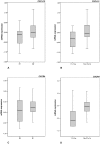Vascular CXCR4 expression - a novel antiangiogenic target in gastric cancer?
- PMID: 20386750
- PMCID: PMC2851611
- DOI: 10.1371/journal.pone.0010087
Vascular CXCR4 expression - a novel antiangiogenic target in gastric cancer?
Abstract
Background: G-protein-coupled receptors (GPCRs) are prime candidates for novel cancer prevention and treatment strategies. We searched for differentially expressed GPCRs in node positive gastric carcinomas.
Methodology/principal findings: Differential expression of GPCRs in three node positive vs. three node negative intestinal type gastric carcinomas was analyzed by gene array technology. The candidate genes CXCL12 and its receptor CXCR4 were validated by real-time reverse-transcription polymerase chain reaction in an independent set of 37 gastric carcinomas. Translation was studied by immunohistochemistry in 347 gastric carcinomas using tissue microarrays as well as in 61 matching lymph node metastases. Protein expression was correlated with clinicopathological patient characteristics and survival. 52 GPCRs and GPCR-related genes were up- or down-regulated in node positive gastric cancer, including CXCL12. Differential expression of CXCL12 was confirmed by RT-PCR and correlated with local tumour growth. CXCL12 immunopositivity was negatively associated with distant metastases and tumour grade. Only 17% of gastric carcinomas showed CXCR4 immunopositive tumour cells, which was associated with higher local tumour extent. 29% of gastric carcinomas showed CXCR4 positive tumour microvessels. Vascular CXCR4 expression was significantly associated with higher local tumour extent as well as higher UICC-stages. When expressing both, CXCL12 in tumour cells and CXCR4 in tumour microvessels, these tumours also were highly significantly associated with higher T- and UICC-stages. Three lymph node metastases revealed vascular CXCR4 expression while tumour cells completely lacked CXCR4 in all cases. The expression of CXCL12 and CXCR4 had no impact on patient survival.
Conclusions/significance: Our results substantiate the significance of GPCRs on the biology of gastric carcinomas and provide evidence that the CXCL12-CXCR4 pathway might be a novel promising antiangiogenic target for the treatment of gastric carcinomas.
Conflict of interest statement
Figures



References
-
- Fenoglio-Preiser C, Carneiro F, Correa P, Guilford P, Lambert R, et al. Hamilton S.R., Aaltonen L.A, editors. Gastric carcinoma: 2000. pp. 39–52.
-
- Dicken BJ, Saunders LD, Jhangri GS, de Gara C, Cass C, et al. Gastric cancer: establishing predictors of biologic behavior with use of population-based data. Ann Surg Oncol. 2004;11:629–635. - PubMed
-
- Alberts SR, Cervantes A, van de Velde CJ. Gastric cancer: epidemiology, pathology and treatment. Ann Oncol. 2003;14(Suppl 2):ii31–36. - PubMed
-
- Dorsam RT, Gutkind JS. G-protein-coupled receptors and cancer. Nat Rev Cancer. 2007;7:79–94. - PubMed
-
- Richard DE, Vouret-Craviari V, Pouyssegur J. Angiogenesis and G-protein-coupled receptors: signals that bridge the gap. Oncogene. 2001;20:1556–1562. - PubMed
Publication types
MeSH terms
Substances
LinkOut - more resources
Full Text Sources
Other Literature Sources
Medical
Molecular Biology Databases

